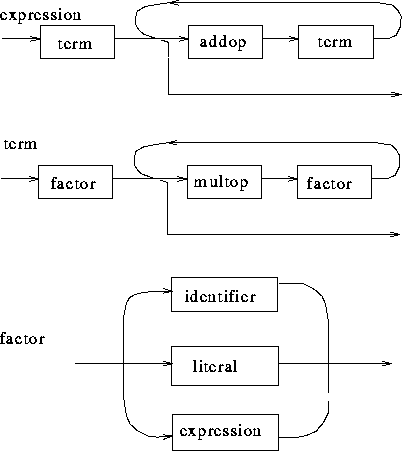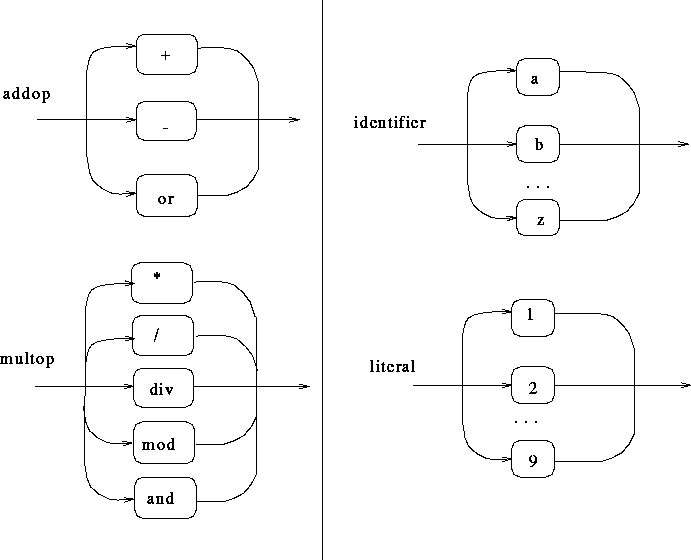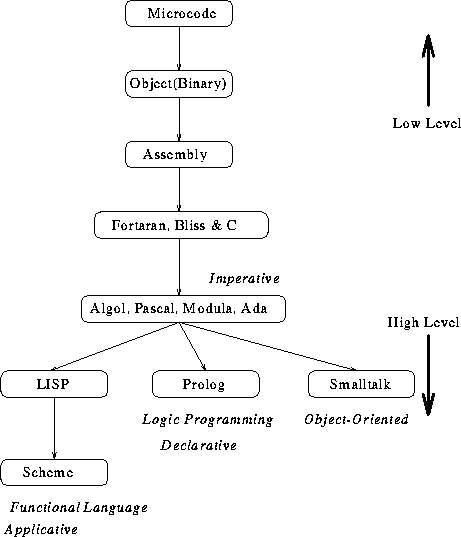 MISHRA 95
MISHRA 95
Lecture #3
Programming Languages  MISHRA 95
MISHRA 95
if a then p if a then p else q if a then if b then p else qConcrete syntax tells us which
then the else-part
matches to.
---Slide 2---
Meta-Languages for Concrete Syntax
---Slide 3---
Backus-Naur Formalisms
a, b,  ,
,
1, 2,  ,
, +, *,
 ,
, or, div, 
<expression>, <term>, <literal>, 
LHS ::= RHS
<expression> ::= <term>
| <expression> <addop> <term>
<term> ::= <factor> | <term> <multop> <factor>
---Slide 4---
Example: Grammar for Expression
<expression> ::= <term>
| <expression> <addop> <term>
<term> ::= <factor>
| <term> <multop> <factor>
<factor> ::= <identifier>
| <literal>
| <expression>
<identifier> ::= a | b | c | ... | z
<literal> ::= 1 | 2 | 3 | ... | 9
<addop> ::= + | - | or
<multop> ::= * | / | div | mod | and
---Slide 5---
Phrase Structure
<multop> than
<addop>.
a + b*c a*b + c
<expression><addop><term>
<multop> and <addop> associate to the left.
a / b / c a - b - c <term><multop><factor> <expression><addop><term>
---Slide 6---
Extended BNF
...|... = choice, (...) = grouping{...} = repetition (zero or more)[...] = optional construct
<expression> ::= <term> {<addop> <term>}
<term> ::= <factor> {<multop> <factor>}
<factor> ::= <identifier> | <literal> | <expression>
<identifier> ::= a | b | c | ... | z
<literal> ::= 1 | 2 | 3 | ... | 9
<addop> ::= + | - | or
<multop> ::= * | / | div | mod | and
---Slide 7---
Syntax Charts
 Sub-Charts
Sub-Charts
 Paths through the charts
Paths through the charts

---Slide 8---
Syntax Charts (contd)

---Slide 9---
Formal Semantics
---Slide 10---
Example: Binary Numerals
 Binary Numerals
Binary Numerals
N ::= 0 | 1 | N0 | N1


---Slide 11---
Semantic Domains


 to its value
to its value  .
.

 is the value of E relative to store s.
is the value of E relative to store s.

 is the result of executing C relative
to store s.
is the result of executing C relative
to store s.
;


---Slide 12---
Hierarchy of Languages

---Slide 13---
Classes of Language
---Slide 14---
Imperative Language: Assignment
X := X + 1; (* Pascal *) X := .X + 1; (* BLISS *) X := !X + 1; (* ML *)
X in LHS is the L-value of X and
X in RHS is the R-value of X.
X refers to the L-value and .X, the
R-value. BLISS allows arithmetic on L-values (pointer
arithmetic). . is an explicit dereferencing
operator in BLISS.
X refers to the L-value and !X, the R-value.
! is an explicit dereferencing operator in ML.
---Slide 15---
L-values
C++:
int a[10];
int& f(int i){return (a[i]);}
f(5) = 17;
f is an L-valued function
EQUIVALENCE construct.
---Slide 16---
Variations on Assignment
L +:= E; (* ALGOL 68 *) L += E; /* C */
L contains the sum of R-values of L and
E. R-value of L is obtained from a single evaluation of
its L-value.
L1 := L2 := ... := Ln := E;
(* ALOGOL 60 *)
L1, L2,  ,
,
Ln, and the R-value of E are evaluated. Then all the
L-values are updated.
---Slide 17---
Variations on Assignment (contd)
L1, L2, ..., Ln := E1, E2, ..., En;
(* ALOGOL 60 *)
L1, L2,  ,
,
Ln, and then all the R-values of E1, E2,
 ,
, En are evaluated. Then all the L-values are updated,
while maintaining positional correspondence.
L := E (* ALOGOL 68 *) L = E /* C */
L. The expression
updates L as a side effect.
if((n += a) > 0) n--; /* C */ a = b = c = d = e; /* C, = is right-associative */
---Slide 18---
Pointer
E whose R-value is an L-valued expression
(or a special value null).
Its L-value is a location giving access to a storage
indirectly. The L-value of E^ is an anonymous variable
which can be updated as any other L-valued expression
E^ := E^ + 1;
In some languages, allocated locations are subsequently disposed of explicitly by the user. In others, inaccessible locations are automatically searched for and disposed--- garbage collection.
new(p); p := nil;
---Slide 19---
Storage Insecurities
Extent (lifetime) of the location ended before all ways of accessing the location have ended.
var p, q: ^integer; var p: ^integer;
begin procedure q;
new(p); var i: integer;
q := p; begin
dispose(p) p := ADDR(i)
end; end;
---Slide 20---
Binding
The later the binding, the more flexible is the language.
---Slide 21---
Referential Transparency
function succ(x:integer):integer;
begin
succ := x + 1;
end;
function succ(y:integer):integer;
begin
succ := y + 1;
end;
---Slide 22---
Types
---Fewer programming errors
---Better compiled code.
---Slide 23---
Type Insecurities & Coercion
var (* PASCAL *) wide:1..100; narrow:10..20; farout:150..300; begin narrow:=farout; wide:=narrow; narrow:=wide end;
var (* PASCAL *)
x: real; i: integer;
x := i;
---Slide 24---
Type Equivalence
declare type BLACK is INTEGER; type WHITE is INTEGER; B:BLACK; W:WHITE; I:INTEGER; begin W := 5; B := W; I := B; end;
---Last Slide---
Type Equivalence (Contd)
--Ada
type T1 is record type T2 is record
X:INTEGER; X:INTEGER;
N:access T1 N:access T2
end record; end record;
type T3 is record type T4 is record
X:INTEGER; X:INTEGER;
N:access T2 N:access record
end record; X: INTEGER;
N: access T4
end record;
end record;

[End of Lecture #3]